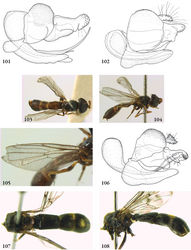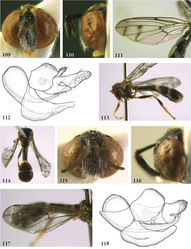Indascia
| Notice: | This page is derived from the original publication listed below, whose author(s) should always be credited. Further contributors may edit and improve the content of this page and, consequently, need to be credited as well (see page history). Any assessment of factual correctness requires a careful review of the original article as well as of subsequent contributions.
If you are uncertain whether your planned contribution is correct or not, we suggest that you use the associated discussion page instead of editing the page directly. This page should be cited as follows (rationale):
Citation formats to copy and paste
BibTeX: @article{Reemer2013ZooKeys288, RIS/ Endnote: TY - JOUR Wikipedia/ Citizendium: <ref name="Reemer2013ZooKeys288">{{Citation See also the citation download page at the journal. |
Ordo: Diptera
Familia: Syrphidae
Name
Indascia Keiser – Wikispecies link – Pensoft Profile
- Indascia Keiser, 1958: 221. Type species: Ascia brachystoma Wiedemann, 1824: 33, by original designation.
Description
Body length: 4–10 mm. Small, slender flies with more or less constricted abdomen. Head wider than thorax. Face convex in profile; narrower than to wider than an eye. Lateral oral margins not produced. Vertex flat. Occiput ventrally narrow, dorsally strongly widened. Antennal fossa about as wide as high. Eye bare. Eye margins in male parallel, not converging at level of frons. Antenna shorter to longer than distance between antennal fossa and anterior oral margin. Basoflagellomere as long as to longer than scape, 1.5 to 5 times as long as wide; parallel-sided or with dorsal margin somewhat concave; bare. Postpronotum pilose. Mesoscutum with transverse suture complete. Scutellum semicircular, apex may be slightly acute; without or with very small calcars. Anepisternum convex or sulcate; entirely pilose or with bare part limited to ventral half. Anepimeron entirely pilose. Katepimeron (moderately) convex; bare. Wing: vein R4+5 with or without posterior appendix; vein M1 perpendicular to vein R4+5 and vein M; postero-apical corner of cell r4+5 rectangular, with small appendix; crossvein r-m located within basal 1/4 of cell dm, sometimes very close to base. Abdomen elongate, at least 3 times as long as wide; constricted, with narrowest point at posterior margin of tergite 2 and widest point at tergite 4. Tergites 3 and 4 not fused. Male genitalia: phallus furcate, with furcation point in distal half; epandrium without ventrolateral ridge; surstylus furcate, with anterior part short, posterior part about twice as long.
Diagnosis
Abdomen constricted. Postpronotum pilose. Mesoscutum with transverse suture complete. Katepimeron bare. Frons laterally without concave area.
Discussion
Originally this genus was included in the tribe Sphegini, as part of a subfamily Cheilosiinae (Keiser 1958[1]). Thompson (1969)[2] correctly recognized that it belongs to the Microdontinae, where it has remained since.
Originally, Indascia was based on two species with short antennae and without a posterior appendix on vein R4+5 (Keiser 1958[1]). In two of the species included in the phylogenetic analyses of Reemer and Ståhls (in press)[3] the antennae are long and the appendix on vein R4+5 is present (Indascia gigantica sp. n. and Indascia spathulata sp. n.). Both characters are also found in additional undescribed species known to the first author. Therefore, these characters are considered not to be of diagnostic value for this genus.
Superficially, species of Indascia look similar to those of Paramicrodon de Meijere, 1913 (as noticed by Cheng and Thompson 2008[4]). For discussion on similarities with Paramixogaster Brunetti, 1923 see there.
Diversity and distribution
Described species: 4. At least four undescribed species are known to the first author. The genus appears to be strictly Oriental, with species known from India, Sri Lanka, Pakistan, Thailand and Vietnam. The origin of the type specimens of the type species (‘India orientalis’) is not exactly known.
Taxon Treatment
- Reemer, M; Ståhls, G; 2013: Generic revision and species classification of the Microdontinae (Diptera, Syrphidae) ZooKeys, 288: 1-213. doi
Other References
- ↑ 1.0 1.1 Keiser F (1958) Beitrag zur Kenntnis der Syrphidenfauna von Ceylon (Dipt.). Revue Suisse de Zoologie 65: 185-239.
- ↑ Thompson F (1969) A new genus of Microdontine flies (Diptera: Syrphidae) with notes on the placement of the subfamily. Psyche 76: 74-85. doi: 10.1155/1969/62102
- ↑ Reemer M, Ståhls G (in press) Phylogenetic relationships of Microdontinae (Diptera: Syrphidae) based on parsimony analyses of combined molecular and morphological characters. Systematic Entomology 38.
- ↑ Cheng X, Thompson F (2008) A generic conspectus of the Microdontinae (Diptera: Syrphidae) with the description of two new genera from Africa and China. Zootaxa 1879: 21-48.
Images
|

